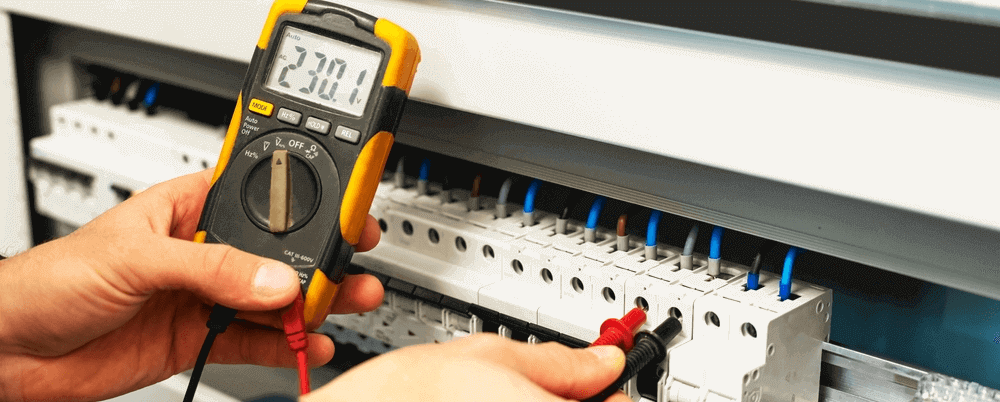KEY POINTS
- A power factor is an electrical engineering term used to describe how efficiently electrical power is used.
- The total energy actually used – called apparent power – is measured in kilovolt-amperes (kVA).
- Calculating the power factor ratio of a system requires only simple division: kW/kVA.
Electricity is one of the largest overheads for many businesses. With power prices soaring, companies need to be as energy-savvy as possible. Having a good power factor is imperative to keeping bills low – yet it’s often overlooked.
This article explains everything you need to know about power factor and power factor correction.
On this page:
What is power factor?
A power factor is an electrical engineering term used to describe how efficiently electrical power is used.
It represents the ratio of the energy required to efficiently power a machine or complete an electrical installation to the total power actually used, which includes electricity wasted through processes such as heat generation.
How do you calculate power factor?
The actual power or working power that electrical equipment use to perform useful work is measured in kilowatts (kW). The total energy used – called apparent power – is measured in kilovolt-amperes (kVA).
Calculating the power factor ratio of a system requires only a simple division: kW/kVA.
For example, if a workshop has machinery that requires 100kW to run, but is measured using 125 kVA, the power factor = 100 / 125 = 0.8.
In a perfect system, a machine that requires 100kW to run would use 100kVA, which is a power factor of 1 (100kW / 100kVA).
So, using our above example, if the machinery has a power factor of 0.8, it’s only 80% efficient.
What are the benefits of a good power factor?
Increasing your power factor will do more than lower your electricity bills. Some other benefits include:
Regulatory compliance
Many energy distributors have a minimum power factor requirement of 0.8. Keeping on top of your power factor means you avoid possible penalties.
Improved equipment life
A higher voltage resulting from a poor power factor may damage your equipment.
Demand charges
If you’re a business that uses a lot of electricity and are on a KVA demand tariff, which charges you for your total power usage, a good power factor will mean lower demand charges and savings on your bill.
Increased capacity
By reducing energy wastage, you’ll free up capacity that can be used to power other high power-usage equipment.
Lower carbon emissions
By reducing your business’ electricity wastage, you’ll lower its carbon footprint.
What is a power factor correction?
Power factor correction (PFC) is the term given to the technology used to improve a low power factor. PFC may be required if your power factor slips below 0.9. Failing to correct a poor power factor won’t just lead to higher power bills, it may also significantly damage sensitive electrical components in equipment and machinery.
Installing PFC equipment can be a cost-effective way to improve your power factor. PFC equipment is essentially a capacitor bank that stores reactive power and repurposes it into usable electricity. Some companies offering PFC services include:
- AGL
- Ampcontrol
- Energy Australia
- Fuseco
- Origin Energy
- Shell Energy
Of course, it’s a good idea to ensure that your power factor never becomes problematic. You can do this by checking the power factor of appliances before you buy them, and ensuring your electrical equipment is calibrated to the right voltage.
Compare energy prices
While you are considering the various aspects of energy, if might be time to compare your energy plan with the cheapest on the market. You can start by checking out the Canstar Blue tool below.
Here are some of the cheapest published deals from the retailers on our database that include a link to the retailer’s website for further details. These are products from referral partners†. These costs are based on the Ausgrid network in Sydney but prices may vary depending on your circumstances. This comparison assumes general energy usage of 3900kWh/year for a residential customer on a single rate tariff. Please use our comparison tool for a specific comparison in your area. Our database may not cover all deals in your area. As always, check all details of any plan directly with the retailer before making a purchase decision.
Here are some of the cheapest published deals from the retailers on our database that include a link to the retailer’s website for further details. These are products from referral partners†. These costs are based on the Citipower network in Melbourne but prices may vary depending on your circumstances. This comparison assumes general energy usage of 4000kWh/year for a residential customer on a single rate tariff. Please use our comparison tool for a specific comparison in your area. Our database may not cover all deals in your area. As always, check all details of any plan directly with the retailer before making a purchase decision.
Here are some of the cheapest published deals from the retailers on our database that include a link to the retailer’s website for further details. These are products from referral partners†. These costs are based on the Energex network in Brisbane but prices may vary depending on your circumstances. This comparison assumes general energy usage of 4600kWh/year for a residential customer on a single rate tariff. Please use our comparison tool for a specific comparison in your area. Our database may not cover all deals in your area. As always, check all details of any plan directly with the retailer before making a purchase decision.
Here are some of the cheapest published deals from the retailers on our database that include a link to the retailer’s website for further details. These are products from referral partners†. These costs are based on the SA Power network in Adelaide but prices may vary depending on your circumstances. This comparison assumes general energy usage of 4000kWh/year for a residential customer on a single rate tariff. Please use our comparison tool for a specific comparison in your area. Our database may not cover all deals in your area. As always, check all details of any plan directly with the retailer before making a purchase decision.
Electricity Providers For Business
Original reporting by Simon Downes
Image Source: Andrea Tosi/Shutterstock



Share this article